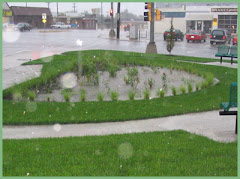Welcome to my Applied Research Project

My research project focus on the retention of
storm water on given building sites. Retention practices for rain water is known as a green design as it allows the water to gradually enter sewers over time or infiltrate into the ground naturally.
Many cities are moving over to retention systems as storm sewers are often over capacity and discharge into creeks or streams causing erosion of banks and increasing flow, destroying habitat in process.
I will apply the measures used in storm water retention practices to a building site scenario and show how they are an effective 'green' design technology.
Planning Outline
EDDT 231
Applied Research Project Outline
Project:
Determining what measures can be taken to keep storm water retained on-site, how it can be recycled back into the building envelope and show how they apply to a specific building site.
Methods:
1.) State why storm water retention should be implemented. Naturalize the land again; help improve eco-system, healthier subdivisions.
2.) Talk about the meaning of retention for a building site. Problems a building site may have in conveying storm run-off. Significance of retention.
3.) Apply a design to a residential/commercial building site. Show the design and specifications of storm water retention recycling systems on elevation, floor plan, and building site drawings.
4.) Explain the change of design standards for municipalities. Over-capacity storm sewers, re-charging ground water, reducing amount of runoff into streams.
5.) Give a background on the measures used to help retention. Show statistics based on several projects throughout North America. Green roofs, roof rainwater storage units, rain gardens.
6.) Talk to engineers at work about their experience on design storm water retention systems for subdivisions and try to implement a design to a specific site.
7.) Read government reports on green roofs and their retention capabilities. Find effectiveness of cisterns, rain gardens. Look at comparison of roof storage tanks specs.
8.) Can alternate storm water management that is applied be effective, appealing, cost efficient? Cost/Benefit of retention based design vs. conventional storm sewers.
Special Problems:
1.) Environmental impacts of conventional storm sewers. Damage to streams and the habitat of wildlife depending on those streams is a major concern. Pollutants can enter the storm system with little or no treatment and into the streams.
2.) Cost of storm water retention systems. Does it cost more than conventional systems? Less? Do the benefits of a retention friendly system outweigh the cost? Should cost even be an issue?
3.) Are retention measures effective? Show statistics of several projects throughout North America using retention systems and prove how they work. Draw a comparison between conventional sewers and retention systems.
4.) Where in North America will recycled storm retention systems be beneficial? Coastal regions, with large amounts of rainfall. Can these systems work in semi-arid regions, like Kamloops?
5.) How often do materials used in recycling practices need replacing? Do they wear down easily/need maintenance?
6.) Which methods of retention recycling are more effective? Does it matter on a given design? Can these methods be combined for a given project?
7.) How is greywater treated back into the building? What can this water be used for? What chemicals are used to clean the water?
Also:
1.) What scale of size should retention systems be to? Should rooftop storage tanks, rain gardens, and green roofs all be used in a single building?
2.) Performance of roof storm water retention tanks. What ones work better and take up less square footage to be effective enough?
3.) Rain gardens and above ground cisterns can promote growth to mosquito larva increasing the risk of West Nile virus. What measures are taken to prevent hatching? Sprinklers, additives to water?
4.) How can storm water retention recycled systems be integrated with other green technologies? Create hydro-electric energy with storm run-off?
5.) Calculating storm run-off flow. Manning’s equation or computer modeling techniques used in engineering offices to find out how much run-off will enter sewers and streams. Compare conventional sewer run-off to a recycling system.
6.) Do land values increase with implementation of greener storm water retention technology? Quality of life of those living in the building increase?




1 comment:
Derek, Your site is looking good. I was searching for rain barrels today and thought of your project. They are available locally at Canadian Tire: http://www.canadiantire.ca/browse/product_detail.jsp?PRODUCT%3C%3Eprd_id=845524442649133&FOLDER%3C%3Efolder_id=1408474396672673&bmUID=1205094501831
The City of Vancouver offers rain barrels at a reduced rate. There is more info at this web site: http://www.cityfarmer.org/rainbarrel72.html
Perhaps this makes more sense in Vancouver where there is more rain, but it may be needed more here where we use more water. What do you think?
Post a Comment